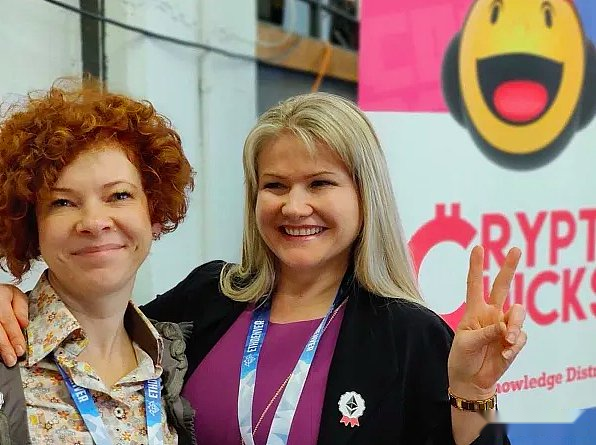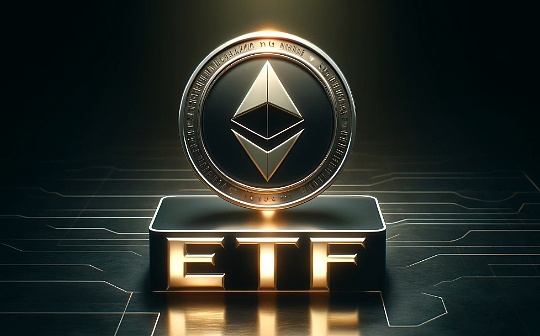
Author: AC-COR
Foreword
Layer2 is considered to be an expansion path of “Ethereum Orthodox”, but Metis is labeled with “Meme Layer2” because there are rumors that Metis’s founding team is “the mother/best friend of Vitalik Buterin”.Metis is called “Meme Layer2”, which is undoubtedly a direct attack on investors against Ethereum’s orthodox belief.However, the essence of the blockchain is still “code+finance”. From the perspective of investment, technology and market have always been a pair of pleasant enemies. Can Metis use other ROLLUP to lack centralized sorters and its own strong economy.The model stands out of many Layer2 projects?
Introduction to Metis

The left is Natalia Ameline, and the right is Elena Sinelnikova
According to the official Metis website, Elena Sinelnikova, co -founder and CEO of Metis, has been committed to promoting education and popularization of the blockchain industry.She is one of the co -founders of Education’s non -profit organization Cryptochicks. Cryptochicks is currently the world’s largest female blockchain community and has members in 56 countries.Another co -founder of Cryptochicks is Natalia Ameline, who is the mother of Vitalik Buterin, the founder of Ethereum.In addition, Vitalik Buterin’s father Dmitry Buterin led the creation of Blockgeeks, a blockchain education company dedicated to developing and blockchain technology -related courses.Metis Network was established in 2018 and released in May 2021.
Metis is a Layer2 based on the Ethereum chain. Following the same principles as other Layer2, it is the earliest fork of Optimism. The biggest attractiveness is that it is the first optimistic Rollup to successfully decentralize sorters.The network uses a POS sorter pool to ensure continuous network availability, resistance, as well as enabled cost sharing and sorter commitments.These sorters are responsible for determining the order of transaction packaging, and must be packed and uploaded to the Layer1 network before the data can be packed and uploaded to the Layer1 network to obtain at least 2/3 signatures of the sorter pool.In order to prevent the malicious behavior of the sorter, Metis also introduced the role of the verification person to sample the block to ensure that the sorter is correctly sorted and traded.
The advantage of MPC (multi -computing) is privacy protection and decentralization, and it is effective for simple Boer operations.However, the obvious disadvantage is that there are no relay nodes to distribute information. The number of communication times has increased, and the communication costs inside the network have increased significantly.In the blockchain network that needs consensus, this disadvantage will be more obvious.In general, Metis transforms a single -point sorter into a set of sorter pools to allow decentralized sorters to reach an agreement to complete the signature and achieve decentralization through node pledge mechanisms and rotation mechanisms.It is much lower than Layer1’s network cost, but it can achieve MEV resistance+solve single -point failure problem, and at the same time distribute income to node pledges.However, neither METIS’s MPC solution nor RADIUS’s public memory pool has not solved the burden of decentralized sorters to the network, and eventually passed the cost to the user’s problem.
The recent surge in Metis TVL has attracted attention to the importance of decentralized sorters. According to L2Beat data, the OP solution is currently ranked fifth in TVL in all Layer2 networks.In addition to the consideration of market value, the author believes that most of the Metis solutions are reasonable and are a standard decentralized sorter solution.The design intention is not only actively allocating cakes, but also to show the value capture of Layer2 native currencies, not only limited to GAS costs and governance.

Source: L2Beat Data Time 24/02/01
Rollup three elements
Rollup is one of the Layer2 solutions and is also known as Rollup.It migrates and stores the transaction calculation and storage of the Ethereum main network (ie, Layer1) to process and compresses it, and then uploads the compressed data to the main Ethereum network, thereby expanding the performance of Ethereum.
Rollup can be divided into ZK Rollup and Optimistic Rollup, which depends on the scheme for ensuring the effectiveness of compression data (that is, the correctness of the data).It involves the calculation of the chain, and the transaction will be packed on the chain every few minutes for packaging verification and bookkeeping, so it will be named.However, even if we usually call it the Rollup chain, the lower part of the rollup chain is not a complete blockchain, but just packing a bunch of transactions to form Rollup transactions, and all nodes that receive Rollup transactions do not execute the packed packaging.Logic, only executes the execution results of the logic.

Source: Author
Sorter
Sequencer is the role of sorting, organizing, packing, and submitting to the Layer1 network in Layer2.At present, most Layer2 projects depend on a single sorter (usually the project itself) to complete the above work. There are also two security problems: 1. Single -point failure.The network will be closed; 2. scalability issues, single sorters may be difficult to cope with increasing transactions.
Value
During the transaction, the packaging data sent by the sorter needs to be verified.At present, most Ethereum Rollup verification is performed by the Ether Rollup smart contract to ensure the reliability of the data.There are two different verification methods: zk rollup (zero -knowledge Rollup) and Optimistic Rollup.
For example:
Zk rollup:
Verification method: ZK Rollup uses zero knowledge to verify the correctness of all transactions on Layer2.Zero knowledge proof allowed verifications to confirm the effectiveness of the transaction without knowing the detailed information of the transaction;
Privacy: ZK Rollup emphasizes user privacy, because the calculated “proof” is submitted at Layer1, not the detailed information of the transaction.The detailed information of the transaction is executed on Layer2, and Layer1 only verifies the effectiveness of zero knowledge proof.
Optimistic Rollup:
Verification method: Optimistic Rollup adopts a “optimistic” strategy, assuming that all transactions are legal and verify only when necessary.Verify the proof of fraud, in which Layer1 submits a certificate of violation of the rules on transactions on Layer2;
Real -time: Because all transactions are legal, transactions on Optimistic Rollup can be completed quickly, and verification is only timely when disputes or differences occur.
DA (data usability)
DA, or data usability, publicly releases the status data of each transaction under the chain so that other participants can also access and use this transaction status data.Some Layer2 write transaction status data into Ethereum Layer1 to achieve DA.There are also some Rollup-Layer2 writing key data into third-party blockchain, where data availability assumes that data is credible.For example:
DA in Optimistic Rollup: Make sure that all transactions on Layer2 are available on Layer1.If the data is not available, anyone can raise objections on Layer1, which helps to prevent potential data tampering or omitted;
Promise in ZK Rollup: Calculate and store all transactions in Layer2, but only submit the calculation results (referred to as promise) to Layer1.The use of zero knowledge to prove that these commitments are correct.
Note: In ZK Rollup, the “promise” is concerned about verifying the correctness of the calculation result of the trading on Layer2, and “data availability” is concerned to ensure that Layer1 can access all transactions on Layer2. Usually these two are complementary.To ensure the security and reliability of the entire system.
Among the three key elements of Rollup, sorters are considered the most critical.The sorter is responsible for sorting and compressing Layer2 transaction information to the chain.Because this process involves verification of data credibility, it may not be so critical to realize data reliability verification and availability, when the sorter is dispersed.
Metis decentralized sorter based on POS consensus

Source: Metisl2
Sortor selection
Metis Rollup introduced a role called “Veritor” during the Layer2 calculation process, and through a competitive mining mechanism to inspire verification nodes to quickly verify the transaction, and improved the “Transaction Data Verification Committee”.It has the role of “verification” in the Layer2 calculation process and quickly verify the transaction through a competitive mining mechanism, which is achieved through the competitive mechanism.Similar to the Layer1 network of other use of equity proof (POS) mechanism, transactions on Metis need to be verified by nodes.Therefore, from Metis to extract assets to the Lord Ethereum network, there will be no interval and delay.
Compared with Optimistic Rollup, a significant difference between Metis Rollup is that it takes only a few hours or a few minutes from Metis to withdraw assets to the Ethereum L1 layer.This highlights the advantages of Metis Rollup in terms of processing transactions.In general, the higher the pledge amount, the higher the probability of the node to add a sorter.Of course, there are certain random components.
The MPC of the sorter (multi -party calculation)
Metis’s decentralization of sorters involves three key roles: administrators, sorters, and POS -based consensus layers.
Administrator: Responsible for setting up key parameters of the entire network, and management adding the sorter qualification to the pool.The agreement party no longer has absolute control of these matters, but is executed by the administrator after the proposal is verified.One of the difficulties when realizing decentralization is that it is necessary to manage the sorter in a decentralized manner, while maintaining efficient and convenient;
Sortter: METIS uses a TSS -based MPC (multi -party calculation) signature to manage the signature permissions of multiple sorters.Each sorter has the right to determine a BATCH and make all sorters participate through the MPC signature method.If the number of signatures exceeds 2/3, Batch is considered valid and can be submitted to the Rollup contract on L1.The MPC signature executed by the sorter pool is managed by another POS network.When the POS network cannot detect the MPC address, the MPC module generates a key;
POS -based consensus layer: POS network is responsible for managing contracts with sorter signature permissions, monitoring MPC addresses and triggering key generation.The generated key is sliced and distributed to each sorter in the pool for MPC signature.The setting of this module includes the life cycle management of the key, including multiple signature generation, key sharing of the key, application signature and deletion of signatures;
The reason for using TSS is its high tolerance and flexibility.Compared with multiple signatures, TSS does not need to verify each signature on the chain. Instead, it aggregates the signatures of all signatures and conduct unified inspections to increase the transaction confirmation rate.In addition, communication between POS nodes use an independent Tendermint channel, while MPC communicates with the libp2p protocol.The design of the entire system aims to achieve efficient and safe decentralized management of sorters.
Metis sorter trading process
1. The first user initiates the transaction; 2. The transaction is forwarded to the sorter network node; 3. Block generation: When the sorter is valid, create a block; 4. Complete: MPC node discussion block mergersAnd forward it to the main chain of Ethereum.
Metisedf
Metis Ecological Development Fund provides financial support for this, covering multiple aspects, such as the development and deployment of incentive protocols, providing liquidity support, conducting security audit and implementation of liquid mining programs.The allocation includes:
Sortter mining: 65.4%(3 million metis / & gt; US $ 260 million);
Ecosystem funds: 34.6%(1.6 million Metis / & GT; $ 140 million).
Sortor centralization problem

Source: Author
The principle of Ethereum is to store and execute each transaction submitted by each node. This high -level security also makes the entire network very expensive. Therefore, it is necessary to expand the capacity of the entire network and adopt the Rollup solution.Simply put, a group of approximate network nodes in Rollup = Layer1+ Layer2, that is, smart contract+ chain polymer on the chain.itself.
-
The smart contract on the chain indicates that its trust model is a smart contract on Ethereum, borrowing the security of Ethereum;
-
The under -chain polymerizer executes and aggregate transactions under the chain, compressed a large number of transactions, and eventually placed them on the main Ethereum network to achieve faster and cheaper transactions.
Layer2 network nodes have multiple components, of which sorter components are the most important.It is responsible for receiving trading requests on Layer2, determining their execution order, and packaging the transaction sequence into a batch, and finally transmitted to smart contracts on Layer1.Although all Layer2 Rollup on Ethereum has a centralized sorter, Metis has seized the opportunity to become a decentralized sorter.
A LAYER2 full node can obtain the transaction sequence in two ways: to obtain directly from the sorter or through the transaction batch sent by the sorter to Layer1 by reading, but the latter has stronger non -tampering attributes.Because the transaction execution will change the status of the blockchain distributed ledger, in order to ensure consistency, the full node of Layer2 must synchronize the distributed ledger status with the sorter, except for the transaction sequence.Therefore, the task of the sorter is not only to send the transaction batch to the ROLLUP contract of Layer1, but also to pass the status update result of the transaction execution results Static/Statediff to Layer1.In general, the work of the sorter is to handle and sort transactions to become a block to add to the blockchain, and be responsible for handling transactions in batches and publishing them to Layer1 smart contracts.
For Layer2 nodes, as long as you get the transaction order on Layer1 and the original Static of Rollup, you can restore Layer2’s blockchain account book and calculate the latest Static. On the contrary, the Static and sorter calculated by Layer2 nodes itself to Layer1 is published to Layer1STATEROOT of smart contracts is inconsistent.It means that the sorter is fraud.In summary, Layer1 is more decentralized, decentralized and secure than Layer2’s own network.
For example, Optimistic Rollup allows all Layer2 nodes to provide Fraud Proof, which proves that the data released by the sorter in layer1 is wrong.But for the Optimism without Fraud Proof, if it really wants to steal the assets of Layer2 users through a sorter, just let the sorter operator forge the transaction order and transfer other people’s assets from Layer2 to their assets, that is,Can.The address, and finally transferred the stolen currency to Layer1 through the Bridge contract that comes with Rollup.
Thinking of Metis
Recently, the biggest Layer2 hype is undoubtedly the upgrade of Cancun, but this is not the only good news for Metis, but is commonly applicable.Putting on the emotion of “Vitalik Buterin’s mother/best friend”, the biggest competition between Metis and other Layer2 is the economic model of decentralized sorters and POS. TVL shows the overall market value feedback of the market’s confidence in Metis users.Essence
Unlike other Layer2 that controls funds and return more benefits to users, OP Rollup’s economic model is strongly controlled and centralized. The tokens are rewarded to the ecosystem to stimulate development and interaction to profitAnd Metis transferred its income and interests to the pledged community for competition, greatly releasing the finance of Layer2 infrastructure, and attracted widespread market attention.
Meme more represents a culture and some socio -economic factors, as if we are in the process of buying Meme, except for ten times, hundreds of times, or even thousands of times, but the process comes from us to Meme to Meme MEMERecognition and love.Its narrative and various factors, but it is always justice, and the growing TVL of Metis is also a feedback on the market’s expected expected market.Aside from the technical level, if you consider attribute issues from the perspective of the market, if Inscript is a testor of public chain performance, then MEME is a tester for market recognition to a certain extent.








